Joe Huang Tries to Differentiate ARTC via Enhancing Value
2008/04/08 | By Quincy Liang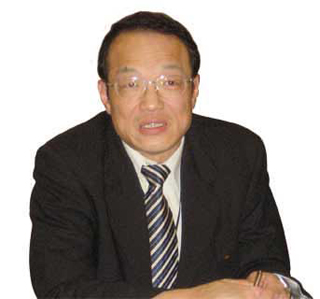
Joe Huang, president of Automotive Research & Testing Center (ARTC), one of the most comprehensive vehicle testing and R&D platforms in Asia, is trying to make his center more different and create more values over next few years though ARTC already runs several global-leading test labs proved by major international labs (such as A2LA of the United States) and automakers (American Big-three) as well as mainstream auto-parts certification standards worldwide (CAPA, TUV, CCC etc.).
"The hardware construction works at ARTC have been initially completed especially during the period between 2000 and 2005," Huang claims, "and what we are doing with the center is upgrading it into a key engineering technical center in Asia and pouring every available resource to upgrade its R&D capability because the R&D is highly related with testing."
In order to attain the center's new goal, the employee number of ARTC will be elevated to around 370 in one to two years from 340 currently and most of the newly recruited staff will be R&D-related talents.
Turning R&D-oriented Testing Center
"Commissioned by both local and foreign clients, ARTC tests numerous products every year with its leading technical capability," Huang points out, "but more important is that from conducting the testing works we can well understand the market trend and utilize our long-cultivated market sensitivity to develop more advanced new products with a technology-leading period of three to five years ahead of the market. Most automotive-related companies in Taiwan are small- and medium-sized enterprises (SMEs), so any failure in new-product development, especially those targets using most-advanced technologies or integrating several advanced techniques in one, might lead to a company's high risk.
"In recent years, ARTC has been actively trying to research market-leading products and techniques, which are increasingly popular when ambitious companies want to become market leaders but its in-house R&D results can not catch up with the rapid-changing market," Huang explains. "Though the overall vehicle production value in Taiwan is not so big, yet the island's auto-parts sector is very potential," the president points out. "ARTC is very confident in helping local parts makers jump onto the international stage and becoming also a vital player in the industry development."
In addition to several matured products and techniques already transferred to private companies, many R&D projects are being conducted by ARTC, including an integration project to map out a homegrown advanced safety vehicle (ASV) that integrate all the development achievements of related local research institutions into one car for testing and accreditation, of which ARTC is responsible for many sub-systems such as the parking assist system (PAS)/auto parking system, emergency brake warning system, open-door warning system, electro-mechanical brake, electrical suspension system, adaptive cruise control, adaptive front-lighting system (AFS), intelligent LED headlamp, electrical power steering, lane-keeping system (LKS), lane departure warning system (LDWS), blind spot information system, intelligent side-mirror etc.
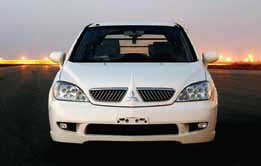
Eye-catching Achievements
With such a strong capability and vision, ARTC has achieved fruitful and meaningful results over the past few years to upgrade Taiwan's auto-parts global competitiveness.
Regarding the AFS, a headlamp orientation control system that takes into account both steering angle and vehicle speed to orient the headlamps to an angle that provides better nighttime visibility, and the trendy LED head-lighting, a system all of the global major first-tier parts suppliers have been intensively working on, ARTC has reported a series of successful achievements.
In 2005, Huang says, ARTC developed a CAN/LIN in-vehicle network for AFS and the needed auto-leveling sensors, while in 2006 the center pushed a fourth-generation LED headlamp model well accommodated to a locally produced car model. In 2007, ARTC won 14 patents (including six for LED technology), several collaboration projects, four technical transfer projects related to AFS/LED head-lighting fields, as well as facilitated three AFS-related and one LED-related production projects. In Taiwan, the center has successfully set up two LED headlamp manufacturing strategic alliances, including one with local original equipment (OE) suppliers and another aftermarket (AM) auto-lamp makers, which are expected to found a solid and leading base for Taiwan to win more chances in the emerging AFS/LED head-lighting global market.
Another major achievement ARTC reached is the advanced PAS, which features trajectory guidance and auto-parking functions. The center has completed development of Field Programmable Gate Array (FPGA)-based PAS module with trajectory guidance, and is continuously working on several related fields such as the space and pedestrian detection, auto-parking control algorithm, steering and brake control mechanism, and system tuning and testing/validation etc.
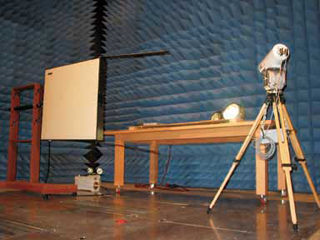
In addition, ARTC has completed the development of Digital Signal Processors (DSP)-based LDWS module and matched electrical steering mechanism and won patents for the driver assistance control method in virtual road camber (applied), while executing related R&D projects for lateral vehicle dynamic model, LKS control algorithm, and system tuning and validation.
The center also completed the development of an advanced Adaptive Cruise Control (ACC) system with functions including automatic vehicle speed pacing, automatic distance keeping, advanced Stop & Go etc. The center is also working on related low-speed car-following control, collision mitigation, and system tuning and validation.
"ARTC will continue to play a vital role in leading the island's automotive key-system R&D," Huang claims. "The center, in fact, is also working on many more advanced projects and already achieved initial success, such as the Electrical Power Steering (EPS, already completed benchmark research), Electrical Suspension System (ESS, suspension refit), Driver Assist System (including the Blind Spot Information System, or BLIS, and Driver Spirit Monitor, or DSM).
Vision Creates Values
Huang, a veteran engineer who stayed at two major local automakers before he took the helm as ARTC president, knows what can create values in the demanding automotive industry--credit. Under his direction, ARTC never stops its step in challenging the world's highest levels for labs so as to convince the world that Taiwan owns the strongest technical capability in conducting automotive testing and research works.
Currently, ARTC runs 12 high-level labs and one world-class proving ground, including calibration lab, component test lab, computer-aided engineering (CAE) center, crash lab, electro-magnetic compatibility (EMC) compatibility lab, environment protection and energy lab, environment test lab, fatigue and durability test lab, lighting test lab, automotive noise and vibration test lab, safety test lab, and vehicle specification test lab. The center's proving ground is the first world-class such facility in Southeast Asia with nine test tracks including test hills; Belgium road; coastdown test track; noise, vibration & harshness surface test track; brake performance test track; pass-by noise test track; general durability test track; high-speed circuit; and general performance test tack.
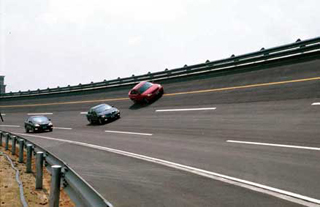
"ARTC has been keeping trying to become the No. 1 automotive engineering technical center in Asia, or the most comprehensive R&D platform of value creation in the region," Huang claims. "We have been actively devoted to R&D works of advanced vehicle systems, as well as cooperating various international certification organizations to provide localized services from R&D, design, manufacture, and performance certification. The goal is to help local complete-vehicle and vehicle-parts industries gain stronger global competitiveness.
One of the many examples that express ARTC's world-class testing capability is the center's EMC lab, Huang explains, which had won the certification from A2LA/AEMCLAP (American Association for Laboratory Accreditation/Automotive EMC Laboratory Accreditation Program) and validation from the Big-Three American automakers GM, Ford, and Chrysler, making it the second and one of the only-three A2LA/AEMCLAP-approved lab in Asia (the first in Japan and the third in mainland China).
"It was a long-term and strenuous effort to pass all the stringent standards for winning approvals from A2LA and the Big-three," Huang points out, "but if we want to differ us from general counterparts, we have to do it best. Today, even Delphi's Korean subsidiary sends their products to ARTC for EMC-compatibility certifications."
In fact, Huang applied to set up the EMC lab in 2002 by forecasting that there would a booming automotive-electronic market over next few years. "When we completed the first three EMC labs at ARTC," Huang says, "items waiting for tests immediately flooded, and now we owns five EMC-compatibility labs."
With Huang's vision, ARTC is almost completing a multimedia test lab and now planning for a wireless telecom lab.
Another good example, according to Huang, is the crash lab completely set up by ARTC in early 2005. The application project for the lab was rejected by the government in the first year, Huang recalls, but over the past about two years, the lab has conducted world-class crash test for over 100 car models.
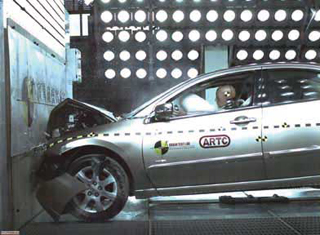
"For ARTC, the most-important meaning of the world-class crash lab is not that it's the first national crash lab on the island, but that its world-class capability attracts international automakers' intensive attentions and chances of technical exchanges," Huang explains.
Huang attributes his vision to his background--an outstanding engineer and marketing good-hand at two largest local automakers before he took the helm as president at ARTC. His history in ARTC might also somewhat explains Huang's brilliant performance as the head of the center--his presidentship already outstripping the third term (three years for one term), compared with predecessors never surpassing four years.
"ARTC has positioned itself not only a backing force to local automotive industry, but also a pushing and leading force," Huang claims with a confident tone.

